A vertical organizational structure is the traditional top-down setup where leaders pass down directions and guidelines to lower-level workers. It shows a hierarchy that starts at the top with the CEO or president. The next level down includes vice-presidents and other executive managers.
Further down are the mid-level managers, front-line managers and the workers. The pyramidal, vertical structure promotes top-down, authoritative relationships between a manager and his subordinates. A primary benefit of this structure is the clear roles of managers and employees. The Vertical corporate organizational structure of a company is given below:
President/CEO
The vertical organizational structure of a company depicts a pyramid with the CEO or the Chief Executive Officer being at the apex of the pyramid.
Responsibilities:
Chief Executive Officer/President
- Developing and recommending the Company’s strategy and developing yearly business plans and budgets and communicating to the Board for approval.
- Running the business and implementing the policies and strategies adopted by the Board.
- Consistently striving to achieve the Company’s financial strategy and operating goals and objectives.
- Monitoring and reporting the Company’s performance and compliance imperatives to the Board.
Top Level management
This is the topmost level of the pyramid and includes the Vice President and the Executive Managers.
Responsibilities:
Vice President
- Vice president’s major roles within an organization are the oversight of one or more departments and he reports to the President or the CEO of the company.
- Vice presidents often play important strategic roles within organizations, because they understand both the long-term goals of the organization as a whole and the specific resources of their departments.
- Vice presidents also serve top-level managerial roles in organizations. While a vice president may not become directly involved in day-to-day human resources decisions, he’s still in charge of setting hiring goals and managing payroll budgets for his department.
Executive Mangers:
- Head responsibility to coordinate and plan top executive corporate meetings.
- They have to carry out the vision, objectives and the mission of the organization.
- Along with setting budgets and allocating funds as needed, executives usually engage in contract negotiations with suppliers, business partners and buyers. You also review financial reports to make financial strategy decisions and revenue or cost adjustment decisions.
- As an executive manager, you also have responsibility for communicating core policies down the organizational hierarchy through regional, district, and store and department level managers.
Middle Level Management
This is the middle level of the pyramid and includes the middle level managers. These managers look after the functions of the different areas of the Organization, such as Accounting, Manufacturing/Services, Research, Development and management of Human Resources and Marketing.
Responsibilities:
Middle Level Managers
- Middle managers are responsible for each of these areas, as well as for specialized units within these functional lines.
- They acquire information from the senior management to know what the strategy is and information from the supervisors to track progress and current conditions.
Low Level Management
This is the lower most level of the pyramid and involves the front-line managers and the supervisors. Their position is between the Middle level management and the workers or operatives.
Responsibilities:
Low Level Managers/Supervisors
- They issue orders and instructions to the workers and to supervise and control their work.
- They even arrange for providing on job training to the workers.
Thus the vertical business hierarchy is the most traditional and easily recognizable structure with clearly defined roles to all its employees for better performance of the organization as a whole.

